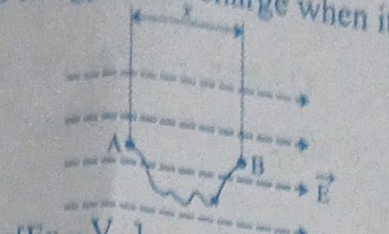A uniform electric field vector \(\vec{E}\) exists along horizontal direction as shown. The electric potential at A is VA . A small point charge q is slowly taken from A to B along the curved path as shown. The potential energy of the charge when it is at point B is


- q[VA + Ex]
- q[Ex - VA]
- qEx
- q[VA - Ex]
The Correct Option is D
Approach Solution - 1
Given:
- A uniform electric field \( \vec{E} \) exists along the horizontal direction.
- The electric potential at point A is \( V_A \).
- A small charge \( q \) is moved slowly from point A to point B along a curved path.
Step 1: Expression for Potential Energy
The potential energy of the charge at point B is given by:
\[ U_B = q (V_A - Ex) \]
Answer: The correct option is D.
Approach Solution -2
The electric potential energy \( U \) of a point charge \( q \) in an electric field \( \mathbf{E} \) is given by: \[ U = qV \] where \( V \) is the electric potential at the position of the charge. In this case, a uniform electric field \( \mathbf{E} \) exists along the horizontal direction, and a point charge \( q \) is moved from point \( A \) to point \( B \). The potential at point \( A \) is given as \( V_A \), and the electric field is uniform, meaning the potential varies linearly with distance. The work done in moving the charge in the electric field is related to the change in potential energy, which can be written as: \[ \Delta U = q(V_B - V_A) \] Since the electric field is uniform, the potential difference \( V_B - V_A \) is related to the distance between points \( A \) and \( B \) by: \[ V_B - V_A = -E \cdot d \] where \( d \) is the distance between \( A \) and \( B \) and \( E \) is the magnitude of the electric field. Therefore, the potential energy of the charge at point \( B \) is: \[ U_B = q(V_A - E \cdot d) \]
Thus, the potential energy at point \( B \) is: \[{q[V_A - E \cdot x]} \]
\(\textbf{Correct Answer:}\) (D) \( q[V_A - Ex] \)
Top Questions on Electrostatics
- Two infinitely long straight wires ‘1’ and ‘2’ are placed \(d\) distance apart, parallel to each other, as shown in the figure. They are uniformly charged having charge densities \(\lambda\) and \(-\frac{\lambda}{2}\) respectively. Locate the position of the point from wire ‘1’ at which the net electric field is zero and identify the region in which it lies.

- CBSE CLASS XII - 2025
- Physics
- Electrostatics
- A dust particle of mass 4 × 10⁻¹² mg is suspended in air under the influence of an electric field of 50 N/C directed vertically upwards. How many electrons were removed from the neutral dust particle? (g = 10 m/s²)
- BITSAT - 2025
- Physics
- Electrostatics
- Two point charges Q and \( -q \) are held \( r \) distance apart in free space. A uniform electric field \( \vec{E} \) is applied in the region perpendicular to the line joining the two charges. Which one of the following angles will the direction of the net force acting on charge \( -q \) make with the line joining Q and \( -q \)?
- CBSE CLASS XII - 2025
- Physics
- Electrostatics
- Consider three metal spherical shells A, B, and C, each of radius \( R \). Each shell has a concentric metal ball of radius \( R/10 \). The spherical shells A, B, and C are given charges \( +6q, -4q, \) and \( 14q \) respectively. Their inner metal balls are also given charges \( -2q, +8q, \) and \( -10q \) respectively. Compare the magnitude of the electric fields due to shells A, B, and C at a distance \( 3R \) from their centers.
- CBSE CLASS XII - 2025
- Physics
- Electrostatics
Given below are two statements: one is labelled as Assertion A and the other is labelled as Reason R
Assertion A: Work done in moving a test charge between two points inside a uniformly charged spherical shell is zero, no matter which path is chosen.
Reason R: Electrostatic potential inside a uniformly charged spherical shell is constant and is same as that on the surface of the shell.
In the light of the above statements, choose the correct answer from the options given below- JEE Main - 2025
- Physics
- Electrostatics
Questions Asked in KCET exam
The circuit shown in the figure contains two ideal diodes \( D_1 \) and \( D_2 \). If a cell of emf 3V and negligible internal resistance is connected as shown, then the current through \( 70 \, \Omega \) resistance (in amperes) is:

- KCET - 2025
- Refractive index
- The mean deviation about the mean for the data \( 4, 7, 8, 9, 10, 12, 13, 17 \) is:
- KCET - 2025
- measurement of angles
- The distance of the point \( P(-3,4,5) \) from the yz-plane is:
- KCET - 2025
- Distance of a Point From a Line
- If 'a' and 'b' are the order and degree respectively of the differentiable equation \[ \frac{d^2 y}{dx^2} + \left(\frac{dy}{dx}\right)^3 + x^4 = 0, \quad \text{then} \, a - b = \, \_ \_ \]
- KCET - 2025
- Differential equations
- If the number of terms in the binomial expansion of \((2x + 3)^n\) is 22, then the value of \(n\) is:
- KCET - 2025
- Binomial theorem